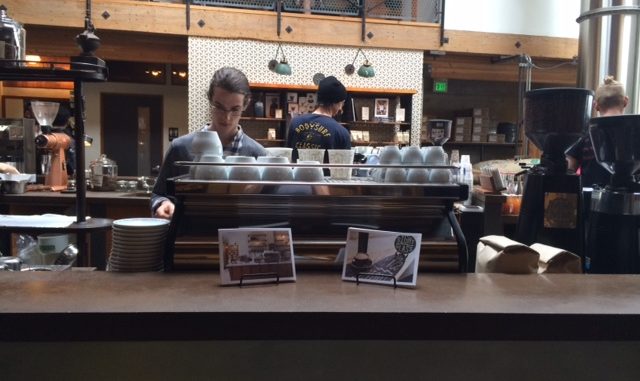
Cafés enjoy efficiency as well as spectacle with dual espresso machines
BY ASHLEY RODRIGUEZ
SPECIAL TO BARISTA MAGAZINE
I once helped a café owner plan out the design and layout of his anticipated second store in Brooklyn. One of the ideas he threw out was having two one-group espresso machines so baristas could make drinks independently of one another. I quickly told him I thought the idea was silly, and referenced other much busier cafes throughout New York that only had one espresso machine.
Many stores don’t have two espresso machines. Many stores are either just not busy enough or don’t have enough space and instead have baristas working side by side: one on shots, and one on milk. But pop into any number of shops in San Francisco and you’ll see two espresso machines, stacked with drinks and manned independently by two different baristas. At first, I wasn’t sure if this was unique to San Francisco or the West Coast in general. After a little bit of investigation, it turns out that the two-espresso machine bar is a very distinct quirk and speaks largely to the coffee culture that has emerged and continues to develop in San Francisco.

œI wanted a second espresso machine at my shop on Valencia by the second Saturday that we were open, says Eileen Hassi, owner and founder of Ritual Coffee Roasters. Eileen opened one of the first specialty-coffee shops in the city in 2005 in San Francisco’s Mission District, and she thinks there’s still room to meet a growing demand for quality coffee. œI think San Francisco is still not yet over saturated, so the places that do a good job with coffee are also very high volume, and having two machines helps keep up the quality while serving the volume.
Although Ritual is certainly busy, volume isn’t the only reason why many San Francisco-based shops have two machines. Just a couple of blocks from Ritual’s flagship store is Four Barrel, another café with not just one, but four fully operational espresso machines according to Matthew Hein of Four Barrel. While he also cites volume as a key reason for adding additional machines, he notes the importance of craftsmanship and autonomy granted to the baristas by working solo on separate machines.

œWe generally like a single barista to make both the espresso and milk for each drink. We think that this allows a little feeling of ownership and responsibility. It also decreases the chance that one or the other will get compromised. Baristas are in control of the drink from start to finish, and having two (or three or even four on the weekends when a Four Barrel barista will cart out a machine in Caledonia Alley around the corner), allows for baristas to craft a complete drink without feeling rushed. œOur goal is to be very fast without sacrificing either crafts-person-ship or hospitality.
The two-machine model also necessitates a level of professionalism and attention to detail that isn’t always inherent in a one-machine set up. œHaving two espresso machines requires clear and concise communication from the cashier to the baristas. Guests need know who is making their drink and where to pick it up. The barista needs to know what specifications the customer asked for, observed Rachel Stanich, educator at Sightglass and the original manager of the company’s Mission-based location. œIf you have two people work in such close quarters of each other, they begin to form their own micro chat session and lose sight of the bigger, cafe picture. Working solo on drinks not only forces baristas to stay extra-focused, but exercises the skills of other staff members as well. Cashiers have to make decisions on which drinks will go to what barista, and keep track of which drinks have made it out to their intended imbibers. Communication skills become especially important in this set up, and everyone on the floor has to be aware of what they need from one another and continuously vocalize those needs.

Hop into any one of these stores, and you’re guaranteed to leave with a quality drink made by a skilled and passionate barista. And while all of them are always line-out-the-door busy, I think the dual-espresso machine set up speaks to the focus on craft and service more than a reflection of volume. œIt’s worth noting how many of our baristas have been working the floor for years, despite the pressures of San Francisco costs of living, Hein added when I asked him about this trend. While a busy line and might have something to do with this, it seems like baristas in the bay value their craft in a way that is unique to the city, and are given the tools to hone their skills and take ownership of the products they make.
 ABOUT THE AUTHOR
ABOUT THE AUTHOR
Ashley Rodriguez thought that she’d take a break from teaching middle school science and putz around in a coffee shop for a few months. She ended up digging it way more than teaching (and was vaguely better at it). After spending 5 years making coffee in New York, she now works for Sightglass Coffee in San Francisco.

